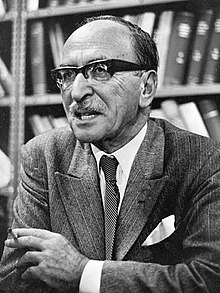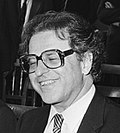Gabor Medal

The Gabor Medal is one of the medals awarded by the Royal Society[1] for "acknowledged distinction of interdisciplinary work between the life sciences with other disciplines".[2]
The medal was created in 1989 to honor the memory of physicist Dennis Gabor, and was originally awarded biennially.[3] Initially awarded "for acknowledged distinction of work in the life sciences, particularly in the fields of genetic engineering and molecular biology", the criteria for the awarding of the medal were later changed to its current definition. It is made of silver.[2] The medal is targeted at "emerging early to mid career stage scientist[s]" and is accompanied by a £2000 prize since 2017. Before that, it accompanied with a prize of £1000. From 2017 it has been awarded annually. All citizens who have been residents of either United Kingdom, Commonwealth of Nations, or the Republic of Ireland for more than three years are eligible for the medal.[2]
The Gabor Medal was first awarded in 1989 to Noreen Murray for her pioneering work in genetic engineering.[4] As of February 2022, the latest recipient of the Gabor Medal is Peter Donnelly.[5]
List of recipients
| Year | Portrait | Name | Citation | Ref. |
|---|---|---|---|---|
| 1989 | 
|
Noreen Murray | "in recognition of her pioneering work in the field of genetic engineering, in particular for her development of the bacteriophage lambda system as a cloning vector for the expression of foreign proteins in E. coli" | [4] |
| 1991 | 
|
Alan Fersht | "in recognition of his pioneering work in the use of protein engineering to study protein structure and enzyme function" | [6] |
| 1993 | 
|
Charles Weissmann | "in recognition of his many contributions to molecular biology, including his innovative analysis of coliphage Q-beta by the introduction of methods for making site-specific mutations, and the cloning and expression of alpha-interferon genes in bacteria" | [7] |
| 1995 | — | David Hopwood | "in recognition of his pioneering and leading the growing field of the genetics of Streptomyces, and for developing the programming of the pervasive process of polyketide synthesis" | [8] |
| 1997 | — | Kenneth Holmes | "in recognition of his achievements in molecular biology, in particular his pioneering analyses of biological structures and viruses, and his development of the use of synchrotron radiation for X-ray diffraction experiments, now a widely used technique not only in molecular biology but in physics and materials science" | [9] |
| 1999 | 
|
Adrian Peter Bird | "in recognition of his pioneering work in the study of global mechanisms by which transcription of the mammalian genome is regulated and for his exploration into the molecular basis of fundamental biological mechanisms, particularly his development of ways of analysing methylation patterns of eukaryotic DNA using endonucleases and the discovery of and continued research into a new class of DNA sequences found in all vertebrates" | [10] |
| 2001 | — | Azim Surani | "in recognition of his discovery of mammalian genomic imprinting, revealing the expression of certain autosomal genes according to the parent of origin. Genomic imprinting has major implications for human genetics and the inheritance patterns of human disease and its discovery has been a major fundamental breakthrough that has changed the way we think about genetics in mammals" | [11] |
| 2003 | — | Jean Beggs | "for her contributions to the isolation and manipulation of recombinant DNA molecules in a eukaryotic organism, adding a new dimension to molecular and cellular biology" | [12] |
| 2005 | — | Lionel Crawford | "in recognition for his work on the small DNA tumour viruses, specifically the papova virus group, papilloma, polyoma and SV40" | [13] |
| 2007 | 
|
Richard J. Roberts | "for his internationally acclaimed contributions to the discovery of RNA splicing and his structural and genetic studies that have extended the range of sequence specificity of restriction and modification of enzymes" | [14] |
| 2009 | — | Gregory Challis | "for his highly interdisciplinary work, exploiting genomics of Streptomyces coelicolor to identify new natural products and biosynthetic enzymes" | [15] |
| 2010 | 
|
Gideon Davies | "for his highly interdisciplinary work into the three-dimensional structures and reaction coordinates of enzymes, which has transformed glycobiochemistry" | [16] |
| 2011 | 
|
Angela McLean | "for her pivotal work on the mathematical population biology of immunity" | [17] |
| 2013 | 
|
Christofer Toumazou | "for his success in applying semiconductor technology to biomedical and life-science applications, most recently to DNA analysis" | [18] |
| 2015 | — | Benjamin Simons | "for his work analysing stem cell lineages in development, tissue homeostasis and cancer" | [19] |
| 2017 | 
|
Richard M. Durbin | "for his outstanding contributions to computational biology, and their impact across many areas of the life sciences" | [20] |
| 2018 | — | Cait MacPhee | "for her seminal contributions to understanding protein aggregation that informed our approach to diseases such as Alzheimer's and diabetes, and opened up new opportunities for creating self-assembled functional biopolymers" | [21] |
| 2019 | 
|
Alison Noble | "for developing solutions to a number of key problems in biomedical image analysis and substantially advancing automatic extraction of clinically useful information from medical ultrasound scans" | [22] |
| 2020 | — | David Ian Stuart | "for his seminal contributions to understanding virus structure and application to vaccine design, as well as driving the application of engineering and physical science to the life sciences" | [23] |
| 2021 | — | Peter Donnelly | "for pioneering work in the genomic revolution in human disease research, transforming the understanding of meiotic recombination, and for developing new statistical methods" | [5] |
| 2022 | — | Graham Medley | "for leading an interdisciplinary team of biologists, clinicians, mathematicians and statisticians who provided SAGE with epidemiological modelling expertise concerning the COVID-19 pandemic" | [24] |
| 2023 | — | Catherine Noakes | "for her pioneering contributions to infection risk modelling and her exceptional leadership in the field through groundbreaking research and a multidisciplinary approach" | [25] |
| 2024 | — | Emily Rayfield | "for her pioneering a new, cross-disciplinary era of engineering-informed computational palaeobiology" | [26] |
See also
References
- ^ StarGuides Plus – A World-Wide Directory of Organizations in Astronomy and Related Space Sciences. Springer Publishing. 2013. p. 566. ISBN 978-0-306-48602-9.
- ^ a b c "Gabor Medal". Royal Society. Archived from the original on 19 July 2018. Retrieved 26 February 2022.
- ^ Year-book of the Royal Society of London. Vol. 110. Harrison and Sons. 2005. p. 372.
- ^ a b Proceedings of the Royal Society of London. Vol. 427–428. Royal Society. 1990. p. 253. Archived from the original on 25 February 2022. Retrieved 20 February 2022 – via Google Books.
- ^ a b "St Anne's Honorary Fellow, Professor Sir Peter Donnelly, awarded the Royal Society' 2021 Gabor Medal". St Anne's College. University of Oxford. 24 August 2021. Archived from the original on 20 February 2022. Retrieved 20 February 2022.
- ^ Atiyah, Michael (1992). "Address of the President, Sir Michael Atiyah, Given at the Anniversary Meeting on 29 November 1991". Notes and Records. 46 (1). Royal Society: 167. JSTOR 531447.
- ^ "Charles Weissmann". Royal Society. Archived from the original on 12 January 2021. Retrieved 26 February 2022.
- ^ "David Hopwood". Royal Society. Archived from the original on 24 November 2015. Retrieved 26 February 2022.
- ^ "Awards". Times Higher Education. 12 September 1997. Archived from the original on 27 April 2019. Retrieved 26 February 2022.
- ^ "Adrian Bird". Royal Society. Archived from the original on 12 July 2018. Retrieved 26 February 2022.
- ^ Carey, Nessa (2012). The Epigenetics Revolution – How Modern Biology Is Rewriting Our Understanding of Genetics, Disease, and Inheritance. Columbia University Press. p. 116. ISBN 9780231530712.
- ^ "Jean Beggs". Academia Europaea. Archived from the original on 28 March 2019. Retrieved 26 February 2022.
- ^ Reynolds, L. A.; Tansey, E. M., eds. (2009). History of Cervical Cancer and the Role of the Human Papillomavirus, 1960–2000. Vol. 38. Wellcome Trust. p. 46. ISBN 978-085484-123-3.
- ^ "Richard Roberts". Royal Society. Archived from the original on 6 October 2015. Retrieved 26 February 2022.
- ^ "Warwick Professor Awarded Medal by the Royal Society". University of Warwick. 14 July 2009. Archived from the original on 28 September 2020. Retrieved 26 February 2022.
- ^ "Gideon Davies". Royal Society. Archived from the original on 15 August 2020. Retrieved 26 February 2022.
- ^ "Oxford Medicine and the Early Royal Society". Oxford Medicine. University of Oxford: 7. July 2011. Archived from the original on 25 February 2022. Retrieved 26 February 2022 – via Issuu.
- ^ "Royal Society Accolades for Manchester Scientists". University of Manchester. 22 July 2013. Archived from the original on 25 February 2022. Retrieved 26 February 2022.
- ^ "Cambridge Scientists Receive Royal Society Awards". University of Cambridge. 20 July 2015. Archived from the original on 17 April 2019. Retrieved 26 February 2022.
- ^ "Richard Durbin Awarded the Royal Society's Gabor Medal". Churchill College. University of Cambridge. 20 July 2017. Archived from the original on 25 February 2022. Retrieved 26 February 2022.
- ^ "Prof Cait MacPhee is Royal Society's Gabor Medal Winner 2018". University of Edinburgh. 20 July 2018. Archived from the original on 28 October 2020. Retrieved 26 February 2022.
- ^ "Professor Alison Noble receives a Royal Society Award". St Hilda's College. University of Oxford. 19 July 2019. Archived from the original on 19 October 2021. Retrieved 26 February 2022.
- ^ "Professor David Stuart awarded The Gabor Medal 2020". Medical Sciences Division. University of Oxford. Archived from the original on 20 February 2022. Retrieved 20 February 2022.
- ^ "Leading infectious disease expert honoured with Royal Society Gabor Medal". London School of Hygiene and Tropical Medicine. University of London. 24 August 2022. Retrieved 26 June 2024.
- ^ "The Royal Society announces this year's medal and award winners". Royal Society. 29 August 2023. Retrieved 26 June 2024.
- ^ "Nobel Prize-winning scientist wins Royal Society's most prestigious scientific award". Royal Society. 28 August 2024. Retrieved 30 August 2024.
External links
 Media related to Royal Society at Wikimedia Commons
Media related to Royal Society at Wikimedia Commons
